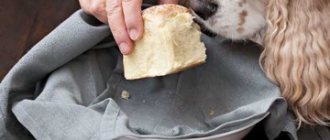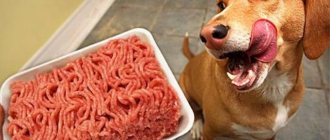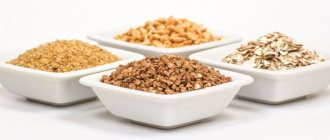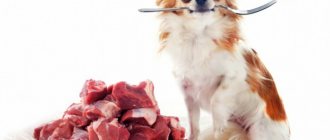It's always nice to share something tasty with a friend, especially if it's your favorite dog. He won't refuse a piece of vanilla muffin, and is that really harmful?
We warn you - it is harmful.
A dog’s digestion is different from a human’s, and no matter how much you would like to feed your pet sweets, you cannot do this. After reading this article, you will learn how to please your dog without harming its health.
The effect of sweets on the body
In the process of evolution, dogs did not gain the ability to metabolize large amounts of saccharides. When glucose enters the digestive system, fermentation begins, which is destructive for predators. A dog needs a certain amount of glucose, but with the right diet, it will get it from vegetables and fruits.
Excessive amounts affect the health of dogs with the following symptoms :
- vomit;
- diarrhea or constipation;
- dizziness.
With constant consumption of sweets, dogs begin to have vision problems: their eyes “sour”, i.e. They begin to tear and fester. Hearing may become weakened. Just like in humans, sweets cause tooth decay in dogs. Dental treatment is an extremely stressful process, as it is only possible under anesthesia, which negatively affects the pet’s brain.
The last stage of sugar poisoning can be:
- allergies;
- skin diseases;
- hair loss;
- liver failure;
- obesity;
- diabetes.
Benefits and harm to the body
If you are wondering whether it is possible to give your dog sugar in its pure form, then remember what was said above. Carbohydrate metabolism in carnivores is much slower than in omnivores. For this reason, they require a lower volume of sweets, and its excess is necessarily stored in fat reserves.
Handouts from the table should be strictly prohibited, since most human sweets for dogs are not only unhealthy, but also toxic. The most dangerous of them include the following:
- Fresh bakery.
When wet it turns into a paste. May cause choking if it gets stuck in the throat or simply make it difficult to digest.
- Confectionery and ice cream.
They contain a large amount of sugar and negatively affect the condition of tooth enamel.
- Chocolate.
Theobromine is not absorbed by the dog's body. It accumulates in the body and causes intoxication.
- Yeast dough.
Provokes fermentation and gas formation. Inside the stomach, it increases in size and causes severe nagging pain.
- Sweeteners.
They are found in chewing gum and even toothpastes. Most of them contain xylitol, a naturally occurring sugar alcohol that is toxic to animals. For this reason, teeth cleaning should only be done with special veterinary toothpastes.
Despite the possible harm, the benefits of glucose, the main breakdown product of sugar, cannot be denied. It is necessary for the normal functioning of brain cells and other important organs. Its natural blood level in four-legged pets is 4.2-7.3 mmol/l. Deviation of this value up or down provokes the development of diabetes mellitus or hypoglycemia.
In addition to refined sugar and granulated sugar, sweets also include those products that contain them. Harm occurs either from excessive consumption or from additives used (dyes, spices, etc.). Regular consumption of chocolate and sweet pastries is fraught with the following consequences:
- Obesity.
All confectionery products are high in calories. This is explained by the fast carbohydrates they contain, which provide energy for a short time. In turn, excess weight causes diabetes, heart pathologies and various liver dysfunctions.
- Digestive disorders.
The pancreas and liver are responsible for processing sugars. With a strong load on these organs, problems with stool and nausea occur. Some fillings can also cause bloating: nuts, raisins and cocoa beans.
- Dental diseases.
A sweet and moist environment is an ideal place for bacteria to grow. Dogs with a sweet tooth often suffer from tooth decay and periodontal disease. Both diseases are treated under anesthesia, which also causes harm to the body.
- Allergies.
Dyes and flavor enhancers often cause flaking of the skin, itching, tearing, swelling of the eyes and hair loss. In some cases, baldness becomes irreversible.
- Psychological dependence.
Another possible problem relates to begging. Regular reward of forbidden food contributes to addiction, so instead of not always successfully weaning it in the future, it is better to simply not give it.
The risk group includes older dogs, representatives of small breeds, as well as animals prone to diabetes. Even small doses of sweets are dangerous for their body, so healthier alternatives should be used as rewards.
IMPORTANT!
The cocoa beans used to make chocolate contain the alkaloid theobromine. It is toxic to animals and can lead to their death from poisoning.
Forbidden sweets
Remember, chocolate is a deadly poison!
Cocoa beans are the most important natural source of theobromine, a substance that is not absorbed by the dog and leads to its death. The lethal dose is 300 micrograms contained in one bitter bar or two milk bars.
Symptoms of poisoning:
- tachycardia;
- digestive disorders;
- restless behavior;
- rapid breathing;
- temperature;
- decrease in pressure;
- convulsions;
- coma.
The reaction depends on the weight and size of the animal. If your Alabai ate two candies, wait for the first symptoms; if there is a reaction, go to the doctor immediately. If your rabbit dachshund is already eating the last of the candy from the box, immediately contact the veterinarian.
The first aid that you can provide yourself is inducing vomiting and activated charcoal (0.5 grams per 1 kilogram of weight). It is advisable to crush the coal and mix it with water, then give it in a spoon or through a syringe. A licensed doctor will do the rest.
Fruits are an excellent substitute for sweets, but there are exceptions :
- persimmon (promotes intestinal obstruction);
- any currant;
- grape;
- peaches, apricots, plums (cause diarrhea);
- watermelons and melons (harm the kidneys);
- any citrus fruits.
In recent years, the number of cases of dog poisoning from sugar substitutes has increased sharply. “This is not sugar,” the owners think. Yes, this is true, but the harm to the animal is the same.
What to do if you eat a lot of chocolate?
If your dog has eaten enough candy, you need to act immediately. Follow the following instructions:
- Try to figure out exactly how much candy the dog ate. You will need this information when visiting a veterinarian. And also check the composition of the confectionery products. The most toxic are dark chocolate candies.
- Call your veterinarian. The specialist will tell you what to do depending on the circumstances: how to provide first aid or take the dog to the clinic. For example, one milk chocolate candy can cause only a slight digestive upset, while a whole bar of dark chocolate can be fatal.
- Take your dog to the veterinarian. Only a specialist has all the necessary knowledge, tools and equipment to determine the consequences of overeating candy. The doctor will also be able to give the animal special vomiting stimulants if overeating occurred no more than an hour ago or admit the animal to the hospital if circumstances require it.
Note! If the situation occurs late at night or at a time when all veterinary clinics are closed, call the 24-hour veterinary support service. The hotline specialists will tell you the sequence of actions.
Could it get bad?
Since candy contains high amounts of carbohydrates, fats and sugar, a dog's delicate liver simply cannot handle it. The most common symptoms that appear are:
- Diarrhea – occurs when you overeat once. The body thus tries to cleanse itself of excess glycogen. If the consumption of sweets was constant, the risk of developing pancreatitis increases.
- Allergic symptoms : red spots, itching, discharge from the eyes and ears, peeling of the skin, bad breath.
If you notice these symptoms, call your veterinarian first. He will prescribe you competent treatment depending on the situation.
With foil, candy wrappers or box
Dogs, particularly puppies, often chew on inedible objects, including cardboard, plastic, foil or cellophane. In some cases, indigestible objects pass out on their own, through vomit or feces. In other circumstances, this can cause intestinal volvulus, poisoning and other negative consequences.
The first thing to do if your dog has eaten candy in candy wrappers is to take him to the vet. The doctor will assess the situation and help free the gastrointestinal tract from inedible objects with the help of medications, or, in extreme cases, with surgical intervention.
Why does a dog ask for sweets?
If your dog has never been known for his love of sweets, but suddenly snatches a cake from the table, his diet may be lacking in useful components and minerals. Ask your veterinarian to recommend a suitable vitamin complex for you. In addition, the dog may not have enough carbohydrates. In this case, sweets will not solve the problem, but the advice of a veterinarian will.
There is another possible explanation. A dog is a social creature that tends to follow its owner. How can you not try a delicacy that the owner likes so much? No matter how pitifully your pet asks you for a piece of cake, you don’t need to give it, these eyes will be much sadder when the first symptoms of poisoning occur.
Is sugar harmful or beneficial to the body?
Can dogs eat cherries, raspberries, apricots and other berries?
Many people misunderstand what sugar actually is. Therefore, they try to exclude it completely from their pet’s diet. But this cannot be done completely. After all, what is sugar? This is carbon (sucrose), which consists of glucose and fructose. Both components are important for maintaining energy balance in the body, as well as cell renewal.
Note! Sugar is found in cereals (there is a lot of it in rice and oatmeal), fruits and vegetables, and, of course, in sweets. Therefore, in order to create a complete menu for your dog and fill in the gaps in the amount of carbohydrates, it is better to replace the sugar from sweets with the sugar found in cereals and fruits. Then this is an absolutely balanced diet.
But pure sugar, which is mostly found in sweets, is harmful to dogs. First of all, there is nothing useful in such products except the carbohydrates themselves. Secondly, carbohydrates are stored in large quantities as fats. Also, an increased amount of glucose in saliva is deposited on the enamel of a dog’s teeth, which is 4 times thinner than a human’s. Glucose is an excellent food and breeding ground for bacteria, so excess sugar in the blood causes tooth decay and gum inflammation.
For your information! With excessive amounts of sugar in the diet and the pet, diabetes occurs, and this cannot be treated, it can only be stopped, so caring for such a dog will be incredibly difficult. Sweeteners are also not suitable for a dog’s body.
What kind of treats can I have?
You can please your pet with fruits and berries that contain the amount of sugar your dog needs and also contain vitamins and minerals. The best choice would be fresh bananas, apples, and raspberries.
Dogs love root vegetables, for example, rutabaga and carrots can be eaten in any form. Pumpkin is also a huge favorite among dogs.
Nuts, such as peanuts and sesame, are very useful for your pet. You should not give a lot of nuts, as the high protein content leads to rapid weight gain. The exception is macadamia nut, which should not be given to dogs.
Honey is an excellent substitute for any sweet delicacy. A huge amount of vitamins and nutrients increase the animal’s immunity. The permissible dose per day is one teaspoon of honey.
Healthy foods containing naturally occurring carbohydrates
In order for the menu to be complete, it is recommended to include vegetables, fruits, and complex carbohydrate products in the diet - they contain fiber, have a low glycemic index and allow you to produce more energy. Add to food:
- Vegetables – carrots, pumpkin, rutabaga, parsnips, beets (has a laxative effect), sweet potatoes.
- Bananas in moderation (overdose causes constipation).
- Apples with mandatory removal of core and seeds.
- Oatmeal and buckwheat.
- Brown bread crackers.
- Melon and watermelon in moderation, as they have a diuretic effect and strain the kidneys.
In addition, pet food manufacturers have mastered the production of industrial treats - crackers, biscuits and others, which contain tasty and nutritious substances that are beneficial for pets.
How to replace harmful things
You can also add a small amount (1 teaspoon) of natural peanut butter to your food, but you should pay attention to the composition. The main thing is that there are no other additives, and the sweetener should be honey.
It was already mentioned above that it is best to choose dried and fresh fruits for this, but do not forget about the dog’s balanced menu. If your dog suddenly starts asking for sweets, then you need to think about whether everything is okay with his diet. Before going to the vet, you can try changing the menu.
First of all, a lack of carbohydrates can occur when the bulk of the diet consists of meat and milk, because the body also needs other substances and microelements. Therefore, in order to improve nutrition and the condition of the body, it is worth adding buckwheat, rice, and wheat cereals to the diet. They must be boiled either in water or in meat broth, but cannot be stewed or fried, or seasonings must be added. It would also be a good idea to supplement your diet with cottage cheese or sour cream.
Important! When the menu consists of the required amount of protein (meat), fat (dairy products) and carbohydrates (porridge), then the likelihood that the dog will ask for sweets is low. In this case, the owner should not even replace the sweets, because there is no need for them.
Your pet needs special treats during training.
The importance of a healthy diet
Caring for a sick dog
If surgery is contraindicated for a dog, it will require lifelong care. The owner injects insulin daily, within a time frame agreed upon with the veterinarian, takes the animal for a walk, and ensures that physical activity is moderate.
When insulin does not get under the skin, the injection should not be repeated, otherwise hypoglycemia will develop. A dog showing signs of ketoacidosis should be hospitalized immediately.
What breeds are at risk?
Doberman Pinschers, exotic, toy and small breeds of dogs are predisposed to diabetes:
- Labrador Retriever;
- beagle;
- pug, poodle;
- dachshund;
- spaniel;
- Pomeranian Spitz;
- Scotch Terrier.
Owners of these dog breeds need to monitor the weight of the animal and conduct blood tests for sugar levels at intervals determined by the veterinarian.
Nutrition for diabetes in dogs
During treatment, the pet is transferred to veterinary nutrition with ready-made food for dogs with diabetes.
Followers of natural food should exclude the following products from their diet:
- fried, sweet, salty, smoked dishes;
- confectionery;
- sweets, candies, chocolate;
- store-bought treats.
A diet of natural products will be agreed upon with a veterinarian.
What sweets and candies are good to give to your dog?
It's not all so sad. Dogs can sometimes be pampered with sweets if done wisely. What desserts are safe for tailed friends?
Fruits
Permitted foods include, for example, apples and unripe bananas. This does not mean that the pet needs to be fed or forced. If your pet wants it, give it a couple of slices. Fruits contain sucrose, the “correct” analogue of glucose. In addition, the treats contain minerals and vitamins.
Berries
Give in small quantities and very carefully to avoid allergies. Many dogs love to eat raspberries. It is acceptable to occasionally pamper your pet with blueberries or blackberries. It is better to avoid grapes and raisins, as they are toxic to the kidneys. A couple of berries will not cause immediate severe poisoning, but will force the body to work to the limit. Regular use will lead to dire consequences.
Nuts
Eligible foods include pine nuts, almonds, cashews and peanuts. The latter is classified as a bean, but we decided to include it here. Salted pistachios, nutmeg and macadamia are dangerous. It is highly recommended to avoid walnuts and hazelnuts. Buy treats only from reputable sources, as there may be mold inside that cannot be seen with the naked eye.
Vegetables
They contain relatively little sugar, but this is enough for a dog. You can offer your pet pumpkin or carrots. A mixture of the latter with an apple will serve as a kind of toothpaste. The tough pulp perfectly removes plaque.
Meat biscuits
Of course, we are not talking about a “human” dessert, but about a special meat analogue. To knead the dough, buckwheat, rye, oat or wheat flour, chicken eggs and minced meat (beef, chicken or fish) are used. It is permissible to add a little honey. Gourmets can offer liver cookies or with oatmeal.
How to prevent diabetes in dogs: prevention?
Veterinarians recommend the following measures to prevent diabetes:
- overweight animals are switched to a diet for weight correction;
- provide daily walking with moderate physical activity;
- bitches who have reached the age of seven, as well as females in whom repeated false pregnancy is detected, are castrated.
Pedigree animals whose puppies are found to have diabetes are excluded from breeding.
Special cubes
During training, you cannot do without a food “reward”, otherwise the process will be long. But sweets are not the best option to reward and pamper your dog. For them, their own special goodies have long been created that do not harm the body, but, on the contrary, improve its condition. There are special cubes and cookies that contain chicken, carrots and spinach. They are suitable for training, as they are not high in calories, but at the same time they contain many microelements.
It is better to replace sweets with special cookies
Medicines containing antiallergic agents and vitamins are also sold in the form of sugar cubes and are used to treat eczema and dermatitis. This is perhaps the only case when you can give a dog sweets so that the dog wants to eat the medicine. But this is contraindicated for dogs with diabetes and pancreatitis, it is prescribed only by an experienced veterinarian; such a remedy cannot even be considered as a treat.
Thus, sweets and chocolates are prohibited for the dog. If you want your dog to live a long, happy, and most importantly, healthy life, it is better to switch to special sweets for dogs, which are sold in veterinary pharmacies.











